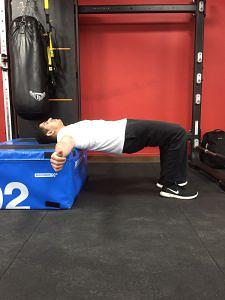So How Should You Warm Up?
- General Preparation Warm Up
- Specific Exercise Warm Up
General Preparation Warm Up
- Mobilise the hip flexors / quads
- Activate the glutes / posterior chain
- Mobilise the shoulders / pecs
- Activate the upper back / rotator cuff
Hip Flexor Mobilisations

Glute Activation Drills
Shoulder Mobilisations
Upper Back / Rotator Cuff Drills
Full Body Warm Up Level #1
- Rocking Hip Flexor Stretch x 10 each side
- Bodyweight Glute Bridge x 10-15
- Band Dislocations x15-20
- Band Pull Aparts x10-30 (to each level)
Full Body Warm Up Level #2
- Rocking Couch Stretch x 10 each side
- Bodyweight Single Leg Glute Bridge x 10-15
- Band Dislocations x15-20
- YTW x10
Full Body Warm Up Level #3
- Walking Lunges With Leg Lift x10 each side
- Back Extensions x10-15
- Handcuffs x10
Upper Body Warm Up Level #1
- Band Dislocations x15-20
- Band Pull Apart x10-30
Upper Body Warm Up Level #2
- Band Dislocations x15-20
- YTW x10
Upper Body Warm Up Level #3
- Handcuffs x10
- Any light row or face pull x10-15
Lower Body Warm Up Level #1
- Rocking Hip Flexor Stretch x10 each side
- Bodyweight Glute Bridge x10-15
Lower Body Warm Up Level #2
- Rocking Couch Stretch x10 each side
- Bodyweight Single Leg Glute Bridge x10-15
Lower Body Warm Up Level #3
- Walking Lunges With Leg Lift x10 each side
- Back Extensions x10-15
Specific Exercise Warm Up
What about exercises later in the workout?
Muscle Activations During Warm Ups
What About Traditional Stretching?




What About Foam Rolling During Warming Up?
What About Jogging In Your Warm Up?
- It allows me to split work and training, as opposed to driving there in 2 minutes and not having the mental break between the two.
- It loosens my body up for the training ahead.
Should I Be Doing More Mobility Outside Of My Sessions?
Concluding The Warm Up
- The general warm up needs to be specific and focused on your problematic areas to help improve range of motion and stability where needed
- You need to adequately prepare your body for heavy weights with properly executed warm up sets







.jpg)
.png)
.jpg)